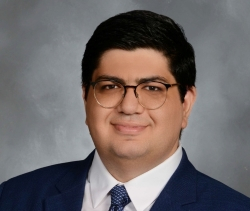Virtual Screening Identifies Potential Small Molecule Drugs for Cancer Immunotherapy
The process of identifying promising small molecule drug candidates that target cancer checkpoints may become faster and smarter through virtual screening, according to Weill Cornell Medicine researchers.
Checkpoint inhibitors are a type of immunotherapy that treats cancer by releasing the brakes on immune cells, so they are unleashed to attack cancer cells. Currently, all approved checkpoint inhibitors are large, lab-made proteins called monoclonal antibodies which must be infused into the bloodstream. They block the binding of checkpoint proteins with their partner proteins, preventing the "off" signal that stops immune T cells from being activated.
“Our research represents a remarkable advancement in the field of cancer immunotherapy, which may lead to a promising alternative to monoclonal antibody-based treatments,” said senior author Dr. Moustafa Gabr, assistant professor of chemistry in radiology.

Dr. Moustafa Gabr
The findings published, Oct. 16 in Science Advances, demonstrate a way to virtually screen millions of compounds to find small molecules with the potential to bind checkpoints allowing the immune system to mount an attack against cancer. Small molecules have an advantage because they are generally orally bioavailable for easier administration, tailored dosing and improved patient compliance. They can also penetrate tumors more effectively due to their smaller size.
The first author on the paper is Dr. Somaya Abdel-Rahman, who is an assistant professor of pharmacy in the department of medicinal chemistry, Mansoura University, Egypt.
Finding the Right Fit
The difficulty in targeting immune checkpoint proteins are their flat and dynamic surfaces that don’t bind small molecules easily. To address this issue, Dr. Gabr and Dr. Abdel-Rahman looked to the co-crystal structures of immune checkpoints bound to monoclonal antibodies.
The researchers used a computational tool that identifies key interacting sites within the protein-protein interfaces of monoclonal antibody-bound checkpoint proteins. This helped them generate “pharmacophore” maps, three-dimensional models that show the essential features of the binding interactions. They then calculated properties such as how tightly the molecules bind together and “druggability” scores, which are essential for the rational design of small-molecule inhibitors.
This analysis guided the virtual screening of a database including millions of commercially available small molecules. The potential hits identified mimicked the binding interactions of monoclonal antibodies with their target checkpoints.
Validating Promising Compounds
The most promising compounds were further tested to confirm binding affinity (how tightly the molecule interacted with the checkpoint protein) and specificity (the ability of the compound to bind only the intended target). They also tested the compounds in cells to assess the functional impact of the small molecules on immune checkpoint activity.

Dr. Somaya Abdel-Rahman
This study identified a molecule called MG-T-19, which strongly inhibited TIM-3, a checkpoint receptor expressed by a wide variety of immune cells. When TIM-3 is blocked, T cell responses against tumors are activated. Another compound called MG-V-53 was identified as a VISTA inhibitor with in vivo antitumor activity. VISTA is another inhibitory checkpoint implicated in tumor immune evasion.
“The small molecules identified in this study not only exhibit strong binding affinities but also show promising activity in mouse models, including reducing the volume of tumors. This suggests their potential for therapeutic development,” Dr. Gabr said.
Future studies will focus on optimizing the top-hit compounds for clinical use, exploring their synergistic effects in combination therapies and expanding this unique screening approach to additional immune targets. “This study demonstrates the potential to expand the repertoire of cancer therapies to improve patient outcomes and open new avenues for research and development,” Dr. Gabr said.
Many Weill Cornell Medicine physicians and scientists maintain relationships and collaborate with external organizations to foster scientific innovation and provide expert guidance. The institution makes these disclosures public to ensure transparency. For this information, please see profile for Dr. Moustafa Gabr.



